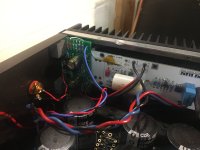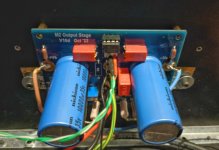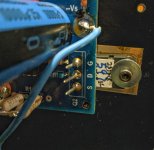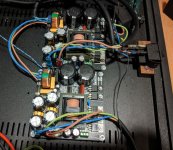So I guess you are happy ? 🤓
How come 4 channels ?
Brave man to build 4 in one go without a test build. 👍
Patrick
How come 4 channels ?
Brave man to build 4 in one go without a test build. 👍
Patrick
Comparing IRFP240/9240 and 2SK3497/2SJ618 in M2OPS
I have been using and enjoying a build of the M2OPS over the last few months. I have this installed in a test chassis (modushop 5U 300mm deep) and somewhat unusually I have it powered from a pair of SMPS300re putting out 28V. The opamps (OP551) can use up to 30V, so this is safe to use, although the supply voltage is high compared to the normal recommendation for the mosfets (24V). It’s what I have to hand and ready to go. Some discussion happened though on what mosfets could be better in this amp (I have been using the widely available IRFP240/9240 pairing) – and I obtained a set of 2SK3497/2SJ618 from @EUVL that came from the same batch that @twitchie used in measurements https://www.diyaudio.com/community/threads/the-m2-output-stage-in-class-a-b-and-maybe-a-power-whammy.390636/post-7206502
When I first built this amp (which is a relatively simple to build and set up amp) I tested out different feedback configurations, and have left it for an extended period using mixed feedback. I think this gives the best of both worlds, but of course, you can try it and see what you prefer yourself. My comments on early listening impressions are at https://www.diyaudio.com/community/...ybe-a-power-whammy.390636/page-4#post-7179607 and ultimately I settled on mixed feedback https://www.diyaudio.com/community/...ybe-a-power-whammy.390636/page-5#post-7189861
It is not possible to get as close as I’d like to an AB comparison – changing the mosfets takes some time, and I don’t have a duplicate system to allow for hot swapping. However, I had lived with the M2OPS with IRFP240/9240 for a good period, so my reasoning is that change should be pretty apparent.
Changing over the mosfets was easy – once you can remove the mosfets without damaging the board. There are no other changes to be made. It is always a good idea to check for shorts etc, before powering up, and maybe even using a lab supply with current limiting/dim bulb tester. This is tricky with SMPS as they often don’t start properly with dim bulb testers. Anyway, power up was uneventful. It is likely that the DC offset will need to be trimmed, just as if you were setting up the amp for the first time, and again that was easily done.
So then the big reveal – did the 2SK3497/2SJ618 pairing sound different? The answer is yes – but not only that it sounded different, in particular that it was easier to hear more small details. I was genuinely surprised at that, because I would have said that the amp was very good at detail already. I would say that the change is not quite as distinct as changing to mixed feedback, but it is definitely there. Adding to this, and maybe this is also part of why I could hear more detail is the soundstage was deeper front to back. Bear in mind the Quad 57s I use are really excellent at soundstage, so maybe this would not be as noticeable with other speaker systems. The extra detail should stand out though. I don’t have systems to carry out noise measurements, nor distortion measurements, so these are very subjective opinions. However, @twitchie did carry out measurements here https://www.diyaudio.com/community/...ybe-a-power-whammy.390636/page-3#post-7172450
The summary is – build the amp first with IRFP240/9240 if you have those to hand, and when you have it setup, you like it, and want to finalise your build, swap in a set of 2SK3497/2SJ618 and you will be set.
I have been using and enjoying a build of the M2OPS over the last few months. I have this installed in a test chassis (modushop 5U 300mm deep) and somewhat unusually I have it powered from a pair of SMPS300re putting out 28V. The opamps (OP551) can use up to 30V, so this is safe to use, although the supply voltage is high compared to the normal recommendation for the mosfets (24V). It’s what I have to hand and ready to go. Some discussion happened though on what mosfets could be better in this amp (I have been using the widely available IRFP240/9240 pairing) – and I obtained a set of 2SK3497/2SJ618 from @EUVL that came from the same batch that @twitchie used in measurements https://www.diyaudio.com/community/threads/the-m2-output-stage-in-class-a-b-and-maybe-a-power-whammy.390636/post-7206502
When I first built this amp (which is a relatively simple to build and set up amp) I tested out different feedback configurations, and have left it for an extended period using mixed feedback. I think this gives the best of both worlds, but of course, you can try it and see what you prefer yourself. My comments on early listening impressions are at https://www.diyaudio.com/community/...ybe-a-power-whammy.390636/page-4#post-7179607 and ultimately I settled on mixed feedback https://www.diyaudio.com/community/...ybe-a-power-whammy.390636/page-5#post-7189861
It is not possible to get as close as I’d like to an AB comparison – changing the mosfets takes some time, and I don’t have a duplicate system to allow for hot swapping. However, I had lived with the M2OPS with IRFP240/9240 for a good period, so my reasoning is that change should be pretty apparent.
Changing over the mosfets was easy – once you can remove the mosfets without damaging the board. There are no other changes to be made. It is always a good idea to check for shorts etc, before powering up, and maybe even using a lab supply with current limiting/dim bulb tester. This is tricky with SMPS as they often don’t start properly with dim bulb testers. Anyway, power up was uneventful. It is likely that the DC offset will need to be trimmed, just as if you were setting up the amp for the first time, and again that was easily done.
So then the big reveal – did the 2SK3497/2SJ618 pairing sound different? The answer is yes – but not only that it sounded different, in particular that it was easier to hear more small details. I was genuinely surprised at that, because I would have said that the amp was very good at detail already. I would say that the change is not quite as distinct as changing to mixed feedback, but it is definitely there. Adding to this, and maybe this is also part of why I could hear more detail is the soundstage was deeper front to back. Bear in mind the Quad 57s I use are really excellent at soundstage, so maybe this would not be as noticeable with other speaker systems. The extra detail should stand out though. I don’t have systems to carry out noise measurements, nor distortion measurements, so these are very subjective opinions. However, @twitchie did carry out measurements here https://www.diyaudio.com/community/...ybe-a-power-whammy.390636/page-3#post-7172450
The summary is – build the amp first with IRFP240/9240 if you have those to hand, and when you have it setup, you like it, and want to finalise your build, swap in a set of 2SK3497/2SJ618 and you will be set.
Attachments
Many thanks to Fran for the very detailed evaluation.
Apart from the much lower distortion of the Toshibas in the M2OPS as measured by Twitchie, the difference in subjective impression is not unexpected.
The 2SK3497 / 2SJ618 belong to the so-called UHC Mosfets, many of which found their way into audio applications a few years ago.
Search UHC-MOS in google, and you will find many Japanese audio / DIY sites showing them in audio applications.
The general remark is that they provide lot of driving capabilities coupled with the capability to reveal fine details.
Which is also not entirely surprising, considering their very high transconductance coupled with relatively low capacitances.
And you can find them in Accuphase amps a few years back, till they became obsolete.
The reason why they are not more widely used, especially in Class A, is probably that they have very high tempco.
This means the drain current shoots up tremendously when they get heated up.
So some form of bias control has to be put in place, and this is not entirely trivial without adding distortions.
The beauty of using them in this circuit is that there is already a bias control in place.
This is provided by the optocoupler sensing the voltage drop across the two MOSFET source resistors.
So bias stability is ensured.
The Toshiba MOSFETs should make the most difference in a low distortion circuit, especially with no or reduced global feedback.
You probably might be disappointed putting them in the original M2 with transformer, as the latter would dominate the distortion signature.
Which is why we asked Fran to test it with the OPA551 first.
We shall follow this with the discrete F5P type front end, as promised before.
https://www.diyaudio.com/community/...-and-maybe-a-power-whammy.390636/post-7136212
So stay tuned,
Patrick
Apart from the much lower distortion of the Toshibas in the M2OPS as measured by Twitchie, the difference in subjective impression is not unexpected.
The 2SK3497 / 2SJ618 belong to the so-called UHC Mosfets, many of which found their way into audio applications a few years ago.
Search UHC-MOS in google, and you will find many Japanese audio / DIY sites showing them in audio applications.
The general remark is that they provide lot of driving capabilities coupled with the capability to reveal fine details.
Which is also not entirely surprising, considering their very high transconductance coupled with relatively low capacitances.
And you can find them in Accuphase amps a few years back, till they became obsolete.
The reason why they are not more widely used, especially in Class A, is probably that they have very high tempco.
This means the drain current shoots up tremendously when they get heated up.
So some form of bias control has to be put in place, and this is not entirely trivial without adding distortions.
The beauty of using them in this circuit is that there is already a bias control in place.
This is provided by the optocoupler sensing the voltage drop across the two MOSFET source resistors.
So bias stability is ensured.
The Toshiba MOSFETs should make the most difference in a low distortion circuit, especially with no or reduced global feedback.
You probably might be disappointed putting them in the original M2 with transformer, as the latter would dominate the distortion signature.
Which is why we asked Fran to test it with the OPA551 first.
We shall follow this with the discrete F5P type front end, as promised before.
https://www.diyaudio.com/community/...-and-maybe-a-power-whammy.390636/post-7136212
So stay tuned,
Patrick
Hello,
I just found this thread when I had just bought the ultra rare original 2SK1530/2SJ201 for M2x for a lot of money. I read on another thread that you were planning a GB with 2SK3497/2SJ618 FET pair. Actually, I haven't read any direct comparison test of IRF240/9240 vs. 2SK1530/SJ201 pairs anywhere, only that many people preferred the Toshiba pair.
Has anyone heard the M2 with both IRF and SK/SJ versions?
Thank you
Gyuri
I just found this thread when I had just bought the ultra rare original 2SK1530/2SJ201 for M2x for a lot of money. I read on another thread that you were planning a GB with 2SK3497/2SJ618 FET pair. Actually, I haven't read any direct comparison test of IRF240/9240 vs. 2SK1530/SJ201 pairs anywhere, only that many people preferred the Toshiba pair.
Has anyone heard the M2 with both IRF and SK/SJ versions?
Thank you
Gyuri
https://www.diyaudio.com/community/...ybe-a-power-whammy.390636/page-6#post-7206882
Very few comparisons around Gyuri.....
Very few comparisons around Gyuri.....
I finally hooked up my M2OPS into my main rig over the weekend and I have to say that it might be the best one yet - i was not expecting this but am pleasantly surprised. The finesse seems to me equal of the SissySit but with much more control and the detail retrieval is excellent. As a reference, I have tried M2X, F4, F7, Aleph, SissySIT. I would rate them as SissySIT-F4-M2X-Aleph on order of preference and have been using F4 primarily as my Sissy started misbehaving after about a year of use. The M2OPS reminds me very much of what I liked about the SissySIT but has much more control over the Maggies ( and many would say that all the other amps have no place driving Maggies but I listen at low levels and it is the low level control that is important which theses amps do well )
I can highly recommend building this amp to anyone who is curious

I went for a barn restoration look - no, just cheap and reused some flooring I had lying around.
I can highly recommend building this amp to anyone who is curious

I went for a barn restoration look - no, just cheap and reused some flooring I had lying around.
.... The M2OPS reminds me very much of what I liked about the SissySIT but has much more control over the Maggies
Then you really should consider 2SK3497 / 2SJ618 as the next step.
We shall offer these AFTER finishing the 2SK3497 GB.
https://www.diyaudio.com/community/...hed-2sk3497-pairs-at-55-c.396555/post-7286152
One a a time.
Patrick
I mean IRF240/9240 and the 2SK1530/2SJ201 pair.
The same remarks apply to the K1530 / J201, which I used in the F5X Power Amp.
The Toshiba MOSFETs (K1530/J201 including) should make the most difference in a low distortion circuit.
You would probably be disappointed putting them in the original M2 with its transformer frontend.
A low distortion output stage is not going to show up as the distortion of the transformer will dominate.
But since you already have them, by all means place them in to make up your own judgement.
Patrick
Hope this isn't totally out of place in this thread. I've put together a M2 OPS with a different front end with some inspiration from this thread. I'm using Tea Bag's M2 clone boards and a 2022 FE board from the store. I listened to the setup initially with local feedback around the front end, and then with nested feedback with about 18dB white wired from the outputs, for about 20dB gain overall. With the mixed feedback, the sound is the best I've gotten from this amp by far. So, another data point for the nested feedback configuration.
Thanks for posting the 2022 FE Spice file, Patrick.

Thanks for posting the 2022 FE Spice file, Patrick.

Attachments
Hope this isn't totally out of place in this thread.
Of course not.
Which PCB you use does not matter. Only the circuit does.
The M2OPS is complementary push-pull.
So we think that a similar frontend may be a better fit.
Hence :
https://www.diyaudio.com/community/...-and-maybe-a-power-whammy.390636/post-7136212
And good to know that someone is making use of my Spice files.
🤓
Patrick
I agree that the F5 pre FE looks intriguing as well and I'm looking forward to more details when they become available. The advantages for me ATM with the 2022 FE are a) board availability (which was good in the short window they were available in the store), and b) mounting hole pattern, which is very convenient for piggybacking on the Tea-Bag board. And of course, it is also a NP design.
I'm currently still using the J113s that came with the board, so I can look forward to evaluating K170s. I'm also intrigued by the Toshiba output FET possibilities as I'm currently using the Vishay IRFP240, Harris IRFP9141 combo there. But first, I will live with this for a while.
I'm currently still using the J113s that came with the board, so I can look forward to evaluating K170s. I'm also intrigued by the Toshiba output FET possibilities as I'm currently using the Vishay IRFP240, Harris IRFP9141 combo there. But first, I will live with this for a while.
K3497 / J618 now on offer :
https://www.diyaudio.com/community/...-matched-2sk3497-2sj618-quads-at-55-c.397291/
🤓
Patrick
https://www.diyaudio.com/community/...-matched-2sk3497-2sj618-quads-at-55-c.397291/
🤓
Patrick
I've been asked what Yfs values these have at 1.3A bias and 55°C.
The average value is about 8S for NMOS, and 5S for PMOS.
These correspond well to the figures shown in the datasheets.
The other question is, what is the output impedance of the M2OPS using them.
Assuming 0R62 source resistors in our example to get ~1.3A bias.
Effective push-pull Zout is about 0.4R.
Depending on how you set up your mixed feedback, you can reduce it by 3x ~ 10x.
The important thing is, not to forget, what distortion (H2 & H3) you get with them.
This has already been published.
https://www.diyaudio.com/community/...-and-maybe-a-power-whammy.390636/post-7206502
Patrick
The average value is about 8S for NMOS, and 5S for PMOS.
These correspond well to the figures shown in the datasheets.
The other question is, what is the output impedance of the M2OPS using them.
Assuming 0R62 source resistors in our example to get ~1.3A bias.
Effective push-pull Zout is about 0.4R.
Depending on how you set up your mixed feedback, you can reduce it by 3x ~ 10x.
The important thing is, not to forget, what distortion (H2 & H3) you get with them.
This has already been published.
https://www.diyaudio.com/community/...-and-maybe-a-power-whammy.390636/post-7206502
Patrick
If 2SK3497/2SJ618 are really better in sound, why Nelson don't use them in the production amplifiers but go for classic IRF240/9240 ?...
Maybe he already have plenty of matched IRFPs ?
You need to ask him.
He also likes 2SK1530/2SJ201 but does not use them in his production amps.
https://www.diyaudio.com/community/threads/which-mosfet-is-best.159920/post-2061244
https://www.firstwatt.com/pdf/art_f5_turbo.pdf
I personally prefer Toshiba active devices.
Lower Vgs and often also capacitances, less Early Effect, very consistent batch to batch.
And I like my amps with little or no global feedback, but also low distortion, including H2.
Patrick
You need to ask him.
He also likes 2SK1530/2SJ201 but does not use them in his production amps.
https://www.diyaudio.com/community/threads/which-mosfet-is-best.159920/post-2061244
https://www.firstwatt.com/pdf/art_f5_turbo.pdf
I personally prefer Toshiba active devices.
Lower Vgs and often also capacitances, less Early Effect, very consistent batch to batch.
And I like my amps with little or no global feedback, but also low distortion, including H2.
Patrick
Last edited:
- Home
- Amplifiers
- Pass Labs
- The M2 Output Stage in Class A/B, and maybe a Power WHAMMY?


